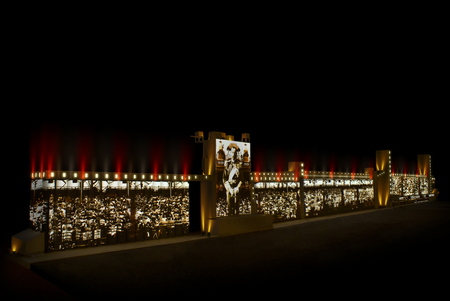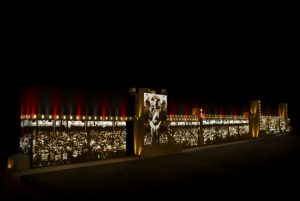In 1608, French explorer Samuel de Champlain founded a settlement in the pre-Canadian wilderness, which he titled kebek, from an Algonguin word that means, “where the river becomes narrow,” which, through French linguistic influence, evolved into Quebec. The city, now the capital of Quebec province, evolved from a sleepy port and trading post on the St. Lawrence River into a thriving, culturally diverse city with approximately 500,000 inhabitants.
Fittingly, city, provincial and federal government officials spearheaded Espace 400, a celebration of the Quebec City’s 400th anniversary. Along with the requisite exhibits, picnics and other festivities, the consortium commissioned Ex Machina, Robert Lepage’s Quebec City-based, multidisciplinary creative-production company, to develop a 40-minute, AV presentation (“equal parts cinema, fireworks and rock concert,” Lepage said) to be shown nightly during summer festivities at 10 p.m. nightly until August 24.
Lepage made an unusual suggestion for the presentation venue – he proposed the 81 contiguous Old Port grain silos, within one of the town’s oldest neighborhoods. Michel Bernatchez, Ex Machina’s senior producer, said the silos’ central location and sheer size – an approximately 2,000-ft.-long x 100-ft.-tall viewing area, three times the area Jean-Michel Jarre achieved when he projected video onto the Egyptian pyramids in 1999 — made them an attractive backdrop.
In keeping with the presentation’s environs, LePage’s team monikered the program the Image Mill. Predictably, the project, for which the governments apportioned $5 million, required approximately four years to develop and a veritable army of specialists. Bernatchez and his team enlisted numerous researchers to pore through thousands of archival documents, books, photos, historical artifacts and other sources of information.
“We didn’t want to establish a linear, timeline theme, or a strictly historical document, because we thought this we would be too confining,” Bernatchez said.
Advertisement
However, Ex Machina settled on four, 10-minute sections that approximate different periods of Quebec City’s history (rough translations of the French names): “the Water Way,” which uses an ice-blue motif to depict the city’s early development as a busy seaport; “the Dirt Road,” which chronicles the growth of new settlements in the region; “The Steel Road,” a representation of Quebec City’s industrial and commercial development through railroads and other infrastructure improvements; and “the Air Way,” a rendition of the city’s progress through the advent of air travel, globalization and the Information Age.
Prominent elements include a collage of religious imagery, which pays homage to the missionaries who played a key role in the city’s early development, and the city’s innumerable beautiful churches, the unveiling of Quebec’s fleur de lis provincial flag in 1948 and its inaugural Winter Carnival, a cultural mainstay, in 1954.
Bernatchez said developing the content required a balance between being too slow, which could bore or disengage the viewer, and too frenetic, which could be overwhelming. Bernatchez said, “If you’re going to build up speed in a visual presentation, it must be done slowly or it will lose the viewer. And, if a subject moves, the background must move similarly to keep pace and maintain legible imagery.”
ETC Audiovisuel (Paris) assumed the Image Mill’s installation. The company installed 27, 20,000-lumen, Christie Digital Systems (Kitchener, ON, Canada) S+20K DLP® projection screens, and ETC’s Onlyview® multimedia control platform managed the diffusion of thousands of images, animations and videos.
To complement the installation, ETC and Ex Machina specified 238 halogen spotlights that bathe the screens, and René Lussier, a Quebecois guitarist and composer, devised the Image Mill’s soundtrack score in collaboration with the content's development; 329 speakers convey Lussier’s arrangement to the audience. The Onlyview system also managed the bandwidth transmission of the Image Mill’s score to a Quebec City radio station.
For more information about the program and the anniversary celebration, visit www.quebec400.gc.ca.
Advertisement


 Photo Gallery2 weeks ago
Photo Gallery2 weeks ago
 Ask Signs of the Times2 weeks ago
Ask Signs of the Times2 weeks ago
 Paula Fargo1 week ago
Paula Fargo1 week ago
 Real Deal6 days ago
Real Deal6 days ago
 Photo Gallery1 week ago
Photo Gallery1 week ago
 Women in Signs2 weeks ago
Women in Signs2 weeks ago
 Projects6 days ago
Projects6 days ago
 Women in Signs2 weeks ago
Women in Signs2 weeks ago
















